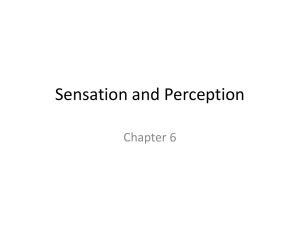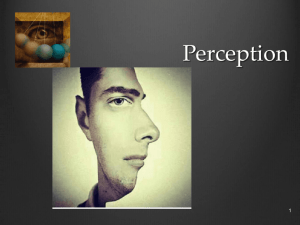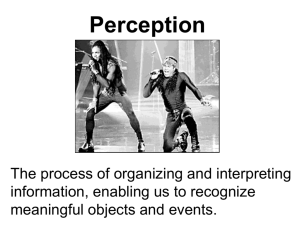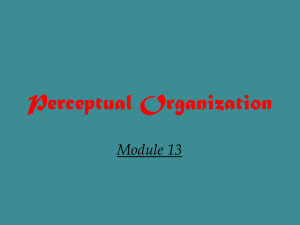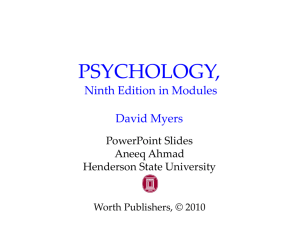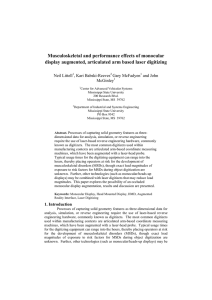Visual Sensory Systems
advertisement
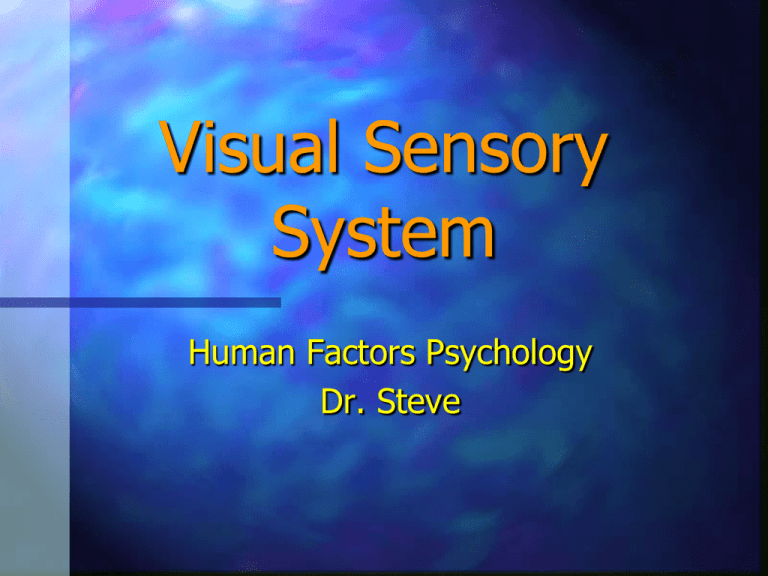
Visual Sensory System Human Factors Psychology Dr. Steve Amplitude Properties of Light Wavelength Light is an electromagnetic wave Amplitude perceived as brightness Wavelength (nm) perceived as hue Physical Measures of Light Luminous Flux – energy of source (units of candela) Illuminance – amount of energy that strikes surface of object (foot candle or lux) Luminance – amount of energy reflecting off the surface of an object (foot lambert) Reflectance – ratio of luminance/illuminance Brightness – perceived intensity Anatomy of the Eye Accommodation Cornea – outer covering of the eye where light is first focused Lens – does the fine tuning Retina – area in back of eye containing photoreceptors Accommodation – changing the shape of the lens to focus images on the retina caused by contracting/relaxing ciliary muscles. - lens flattens (muscles relax) when focusing on distant objects and becomes rounder for focusing on close objects (muscles contract causing fatigue). Myopia – nearsightedness caused by inability to flatten the lens enough to focus image on retina (may be due to elongated eye) Presbyopia – farsightedness that occurs naturally with age as the lens becomes less flexible. Color Vision CIE Color Space – 2-D representation of 3-D color space – Hues more saturated (pure) at rim, diluted toward the center (white) – X axis – long wavelengths (red) – Y axis – medium wavelengths (green) – All colors represented by x,y coordinates – Center is white – combo of all wavelengths Color Vision Types of color deficiences and color blindness (click to see what color blind see) Protanomaly (1% of males) – low sensitivity to red (low λs) Deuteranomaly (6% of males) – low sensitivity to green (med λs shifted to red) Protanopia (<1% of males) – see in shades of blue and yellow – neutral pt as grey Deuteranopia (<1% of males) – see in shades of blue and yellow – neutral pt as grey Tritanomaly/Tritanopia (very rare in both sexes) – blue-yellow deficiency/blindness Monochromacy (extremely rare) – inability to distinguish any colors Photoreceptors Rods – sensitive to dim light (night vision) - found mostly in periphery - why can see a dim star better if look a few degrees to one side Cones – sensitive to color (daylight vision) - concentrated in fovea - provides fine detail light Color Vision Trichromatic Theory Wavelength (nm) Trichromatic Color Theory – color perception is determined by ratio of activity in three different cone mechanisms with different spectral sensitivities (like R B G monitors) White curves indicate sensitivity of three types of cones (color vision); Black curve indicates sensitivity of rods (night-time vision) Purkinje Shift -Purkinje shift – as we switch from cone to rod vision (day to night), shorter wavelengths appear brighter (green objects appear brighter, red objects appear darker). - (Human Factors application: How does the Purkinje shift play a role in the design of fire trucks?) Color Vision Opponent Process Theory Hering’s Opponent Process Theory: Eye contains antagonistic responses to 3 pairs of colors Color Vision Opponent Process Theory Stare at center of the flag for 30 sec. Then look at blank white surface. What do you see? How does this support the opponent process theory? Dark Adaptation -Takes about 30 minutes to dark adapt, but just a few minutes to light adapt (Human Factors application: why are red lights used in cockpits and darkrooms?) - because rods are insensitive to longer wavelengths (red) the eyes “think” they are in the dark already allowing user to dark adapt more quickly) Visual Acuity 20/20 Vision – a person can see from 20 feet what a person with “normal” vision can see from 20 feet 20/40 Vision – a person can see from 20 feet what a person with “normal” vision can see from 40 feet Snellen Eye Chart Contrast and Visibility Variable Effect Example Contrast Visibility Black on gray Illumination Contrast Sensitivity Reading map in poor light Polarity Black on white Viewgraphs Spatial Frequency Optimum CS at 3 C/D Font sizes Visual Accommodation CS Night driving Motion CS Traffic signs Spatial Frequency 0.5% Contrast 100 % Low High Spatial Frequency Reading Text Contrast, Spatial Frequency (Font Size) and Font Style must be considered in the display of text for optimum legibility (Human Factors Application: While the green background provides good contrast and the font size is highly legible, the font style does not allow for visual separation of letters.) Megaflicks Video Top-Down vs. Bottom-Up Processing Experience • knowledge • expectations • desires Top-Down Perception Bottom-Up Stimulus World • Five senses Monocular Depth Cues Linear Perspective - converging parallel lines Relative Size - if 2 objects are known to be similar size, the smaller one appears further away Ames room illusion fools us into thinking that the distance is the same to both people in the photo, therefore their size must be different. Monocular Depth Cues Interposition - Nearer objects obscure the view of further objects Light & Shading - 3-D objects cast shadows and shade on opposite side of illumination source, and reflections on same side Monocular Depth Cues Textual Gradients - Texture appears more fine with increasing distance Aerial Perspective - Objects in the distance appear hazy or bluish Monocular Depth Cues Cool Examples of Monocular Depth Cues Motion Parallax - As perceiver moves, objects in foreground appear to move by faster than objects in background Binocular Cues Convergence - Eyes rotate inward as object gets closer Retinal Disparity - Slightly different image to each eye, brain combines them Retinal Disparity (3D T-Rex) Click for more anaglyphs: Depth Perception Identify the monocular cues to depth perception in this photo. How does top-down processing affect your perception? Visual Search QQQQQQQQ QQOQQQQQ QQQQQQOQ QQQQQQQQ QQQOQQQQ QQQQOQQQ Serial Search Search time: T = (N x I) / 2 I = inspection time per object N = total number of objects OOOOOOOO OOOXOOOO OXOOOOOO OOOOOOXO OOOOOOOO OOOOXOOO Parallel Search Pop-out Effect - conspicuities Signal Detection Theory Signal Detection Theory Actual State Signal Present Signal Absent (Strike) (Ball) Yes (Swing) Operator Response No (Hold up) Hit P(H) False Alarm P(FA) Base Hit! Swinging Strike Miss 1 – P(H) Correct Rejection 1 – P(FA) Called Strike Ball Signal Detection Theory Receiver Operating Characteristic Curve 1.0 P(H) SDT Homework 0 0 P(FA) 1.0 Homework Answers SDT Application Think of some situation to which you can apply signal detection theory. 1. What do each of the outcomes (hit, miss, false alarm, correct rejection) mean in the context you are thinking about? What are their consequences? 2. How great do you think d' (the sensitivity) is in this situation (is there a lot or little overlap between the 'signal' and 'noise' curves)? How might we change d' in this situation? 3. What might cause people to adopt a certain b (the criterion) in this situation? Is a risky or a conservative criterion preferable? How might we change b in this situation? 4. What might be a consequence of examining the situation using signal detection theory rather than simply monitoring with one standard assessment measure (hits, false alarms...)? Applications of SDT •Medical diagnosis •Police identification line-ups •Monocular and binocular depth perception •Items on a radar screen on collision paths •Discriminating smells [gas leak detection] •Parapsychology -- extra sensory perception •Drug testing in personnel selection •Baseball -- swing at a pitch or not •Military detection (camouflaged objects) •Effectiveness of radar & night vision devices •Driving -- safe to go through a gap/overtake •Emergency / fire detection -- dispatch of ambulances
